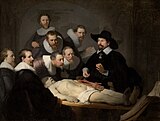Thành viên:Naazulene/Thuật ngữ giải phẫu
| ||
|
|
||
Hệ thống thuật ngữ của giải phẫu là một hệ thống thuật ngữ được sử dụng bởi nhà giải phẫu, nhà động vật học và chuyên gia y tế như bác sĩ, dược sĩ, điều dưỡng,...
Hệ thống thuật ngữ của giải phẫu sử dụng nhiều từ và hình vị lạ, gốc Hán Việt (hay tiếng Hy Lạp và Latin đối với ngôn ngữ Indo-European). Kết quả là những thuật ngữ giải phẫu thường khó hiểu với những người không học giải phẫu, nhưng lại chính xác hơn, tránh mập mờ và sai sót. Thêm vào đó, vì chúng chỉ được sử dụng trong văn cảnh khoa học, ngữ nghĩa của chúng ít có khả năng tiến hóa và thay đổi theo thời gian.
Mỗi hình vị trong tiếng Việt thường tương đương với một hình vị trong tiếng Pháp hoặc Anh.
Một ví dụ của sự thiếu chính xác của ngôn ngữ hàng ngày: một vết sẹo "dưới cổ tay" có thể nằm trên cẳng tay và cách cổ tay 5-6cm, hay gần sát cổ tay, và có thể nằm ở bất cứ mặt nào của cẳng tay. Sử dụng thuật ngữ giải phẫu giúp loại trừ sự mập mờ này.[1]
An international standard for anatomical terminology, Terminologia Anatomica has been created.
Cấu tạo từ[sửa | sửa mã nguồn]
Hệ thống thuật ngữ của giải phẫu có Anatomical terminology has quite regular morphology: the same prefixes and suffixes are used to add meanings to different roots. The root of a term often refers to an organ or tissue. For example, the Latin names of structures such as musculus biceps brachii can be split up: musculus for muscle, biceps for "two-headed", and brachii as in the brachial region of the arm. The first word describes what structure is being spoken about, the second describes an instance of this structure, and the third points to its location.[1]
When describing the position of anatomical structures, structures may be described according to the anatomical landmark they are near. These landmarks may include structures, such as the umbilicus or sternum, or anatomical lines, such as the midclavicular line from the centre of the clavicle. The cephalon or cephalic region refers to the head. This area is further differentiated into the cranium (skull), facies (face), frons (forehead), oculus (eye area), auris (ear), bucca (cheek), nasus (nose), os (mouth), and mentum (chin). The neck area is called the cervix or cervical region. Examples of structures named according to this include the frontalis muscle, submental lymph nodes, buccal membrane and orbicularis oculi muscle.
Sometimes, unique terminology is used to reduce confusion in different parts of the body. For example, different terms are used when it comes to the skull in compliance with its embryonic origin and its tilted position compared to in other animals. Here, rostral refers to proximity to the front of the nose, and is particularly used when describing the skull.[2]:4 Similarly, different terminology is often used in the arms, in part to reduce ambiguity as to what the "front", "back", "inner" and "outer" surfaces are. For this reason, the terms below are used:
- Radial referring to the radius bone, seen laterally in the standard anatomical position.
- Ulnar referring to the ulna bone, medially positioned when in the standard anatomical position.
Other terms are also used to describe the movement and actions of the hands and feet, and other structures such as the eye.
History[sửa | sửa mã nguồn]
International morphological terminology is used by the colleges of medicine and dentistry and other areas of the health sciences. It facilitates communication and exchanges between scientists from different countries of the world and it is used daily in the fields of research, teaching and medical care. The international morphological terminology refers to morphological sciences as a biological sciences' branch. In this field, the form and structure are examined as well as the changes or developments in the organism. It is descriptive and functional. Basically, it covers the gross anatomy and the microscopic (histology and cytology) of living beings. It involves both development anatomy (embryology) and the anatomy of the adult. It also includes comparative anatomy between different species. The vocabulary is extensive, varied and complex, and requires a systematic presentation.
Within the international field, a group of experts reviews, analyzes and discusses the morphological terms of the structures of the human body, forming today's Terminology Committee (FICAT) from the International Federation of Associations of Anatomists (IFAA).[3][4] It deals with the anatomical, histological and embryologic terminology. In the Latin American field, there are meetings called Iberian Latin American Symposium Terminology (SILAT), where a group of experts of the Pan American Association of Anatomy (PAA)[5] that speak Spanish and Portuguese, disseminates and studies the international morphological terminology.
The current international standard for human anatomical terminology is based on the Terminologia Anatomica (TA). It was developed by the Federative Committee on Anatomical Terminology (FCAT) and the International Federation of Associations of Anatomists (IFAA) and was released in 1998.[6] It supersedes the previous standard, Nomina Anatomica.[7] Terminologia Anatomica contains terminology for about 7500 human gross (macroscopic) anatomical structures.[8] For microanatomy, known as histology, a similar standard exists in Terminologia Histologica, and for embryology, the study of development, a standard exists in Terminologia Embryologica. These standards specify generally accepted names that can be used to refer to histological and embryological structures in journal articles, textbooks, and other areas. As of September 2016, two sections of the Terminologia Anatomica, including central nervous system and peripheral nervous system, were merged to form the Terminologia Neuroanatomica.[9]
Recently, the Terminologia Anatomica has been perceived with a considerable criticism regarding its content including coverage, grammar and spelling mistakes, inconsistencies, and errors.[10]
Vị trí[sửa | sửa mã nguồn]
Anatomical terminology is often chosen to highlight the relative location of body structures. For instance, an anatomist might describe one band of tissue as "inferior to" another or a physician might describe a tumor as "superficial to" a deeper body structure.[1]
Tư thế giải phẫu[sửa | sửa mã nguồn]
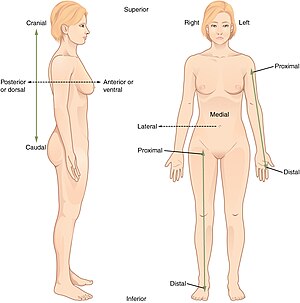
Tất cả những thuật ngữ giải phẫu được dựa trên một tư thế chuẩn, gọi là tư thế giải phẫu chuẩn. Tư thế này là một người đứng thẳng, hai chân mở, bàn tay mở và hướng về trước.[11] Cũng như hướng bắc luôn ở trên cùng của bản đồ địa lí, "bản đồ" giãi phẫu chuẩn vẽ một người đứng thẳng, chân mở bằng vai, bàn chân song song, mũi chân hướng về trước. Hai tay hai bên, bàn tay hướng về trước.[1]
Sử dụng tư thế giải phẫu chuẩn giúp loại trừ sợ mơ hồ. Dù cơ thể người đang ở tư thế nào, vị trí tương đối của nhwungx vùng trên cơ thể họ có thể được mô tả một cách rõ ràng.[1]
Vùng[sửa | sửa mã nguồn]
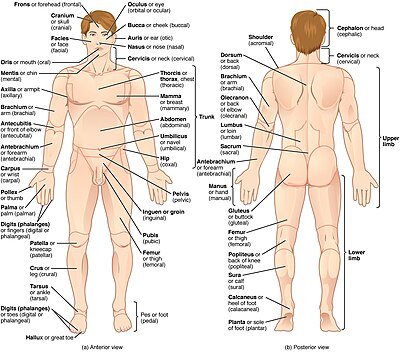
Trong giải phẫu, cơ thể người được chia thành các vùng. Trong tiếng Việt thì tên các vùng này khá quen thuộc. Một số sự phân chia đáng chú ý là
Bụng[sửa | sửa mã nguồn]
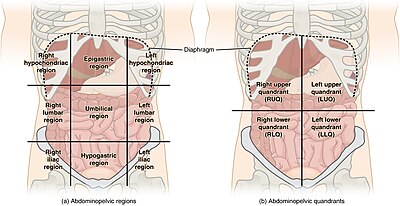
Để giao tiếp hiệu quả, ví dụ khi nói về vị trí cơn đau bụng của người bệnh, vùng bụng được chia thành chín vùng hoặc bốn phần tư.[1]
- Các phần tư
Bụng có thể được chia thành bốn phần tư bằng một đường dọc và một đường ngang đi qua rốn (umbilicus).[1] Bốn phần tư đó được đặt tên là, và bao gồm những cơ quan:[11]
- Phần tư trên phải (RUQ): một số xương sườn thấp, một phần kết tràng ngang, một phần của gan.
- Phần tư trên trái (LUQ): một số xương sườn thấp, một phần kết tràng ngang, dạ dày (bao tử), lá lách.
- Phần tư dưới phải (RLQ): một phần ruột non, nửa xương chậu, kết tràng lên, một phần bàng quan (bóng đái).
- Phần tư dưới trái (LLQ): một phần ruột non, nửa xương chậu.
- Các vùng
Để kĩ hơn, bụng được chia thành chín vùng bằng hai đường dọc và hai đường ngang. Hai đường dọc (hai đường trung đòn) đi qua trung điểm của mỗi xương đòn, tương ứng với đường bên của cơ thẳng bụng. Đường ngang trên là đường hạ sườn, nằm ở điểm thấp nhấn của mạn sườn; đường ngang dưới gọi là đường ụ trán, cắt ngang qua gai chậu phía trước (vị trí trái và phải nhất của xương chậu).[1]
Chín vùng được chia ra có tên là:
| Hạ sườn phải
(right hypochondriac) |
Thượng vị
(epigastric) |
Hạ sườn trái
(left hypochondriac) |
| Mạn sườn phải
(right lumbar) |
Vùng rốn
(umbilical) |
Mạn sườn trái
(left lumbar) |
| Hố chậu phải
(right iliac) |
Hạ vị
(hypogastric) |
Hố chậu trái
(left iliac) |
Thuật ngữ chuẩn[sửa | sửa mã nguồn]
Trong giải phẫu, bắt cứ khi nào nhắc về trái phải là nói từ góc nhìn của bệnh nhân.
Để rõ ràng, họ sử dụng các thuật ngữ, những thuật ngữ đó bao gồm (đi kèm là ví dụ):[2]:4
- trước (anterior) và sau (posterior): ngón chân ở trước gót chân, và hố khoeo nằm sau xương bánh chè.
- trên (superior) và dưới (inferior): hốc mắt ở trên hốc miệng, vùng chậu ở dưới vùng bụng
- gần (proximal) và xa (distal): vai gần tay, bàn chân xa đầu gối
- nông (superficial) và sâu (deep/profound): da nông hơn xương, não sâu hơn xương sọ
- giữa (medial) và bên (lateral): vai bên hơn tim, rốn giữa hơn hông, bề giữa của đầu gối trái và bề hướng về đầu gối còn lại
- quay (radial) và trụ (ulnar): là hai bên của cẳng tay, bề quay là bề có ngón cái, bề trụ là bề có ngón út. Để đỡ nhầm lẫn thì người ta có thể dùng giữa (tương đương với trụ) và bên (tương đương với quay)
- bụng (ventral) và lưng (dorsal): là bề trước và bề sau của thân mình (trong tư thế chuẩn, không xoay vặn)
- phía mỏ (rostral) và phía đuôi (caudal): là gần mũi hay xa mũi hơn; mắt hướng mỏ hơn gáy, xương cụt hướng đuôi hơn ngực.
- phía đầu (cranial) và phía đuôi (caudal): là gần đầu hay gần thân dưới hơn
- trái (left/sinister) và phải (right/dexter)
- cặp (paired): tay là cấu trúc cặp
Các trục[sửa | sửa mã nguồn]
Mỗi thuật ngữ chỉ vị trí trong danh sách trên có thể được dùng để chỉ hướng của vector và trục (cặp vector). Ví dụ, máu có thể chảy theo hướng gần và hướng xa. Những trục của cơ thể (tương ứng với trục x, y, z của hệ tọa độ Descartes) là trục trước sau, trục giữa bên và trục trên dưới. Mỗi cặp trục này định nghĩa một mặt phẳng.
Các mặt phẳng[sửa | sửa mã nguồn]
Giải phẫu thường được mô tả theo các mặt phẳng tưởng tượng chia cơ thể thành hai phần. Có ba mặt phẳng được nhắc đến nhiều: [1][2]:4
- Mặt phẳng đứng dọc (sagittal): là các mặt phẳng chia cơ thể hoặc một cơ quan theo chiều đứng thành nửa trái và nửa phải. Nếu nó chia cơ thể thành hai phần bằng nhau, nó gọi là mặt phẳng đứng dọc giữa, nếu nó chia cơ thể thành hai phần không bằng nhau, nó được gọi là mặt phẳng đứng dọc bên. [1]
- Mặt phẳng đứng ngang (frontal/coronal): là mặt phẳng chia cơ thể theo chiều đứng thành trước và sau. [1]
- Mặt phẳng ngang (transverse): là mặt phẳng chia cơ thể thành phần trên và phần dưới. Mặt cắt là vùng tiếp xúc của mặt phẳng cắt ngang với cơ thể[1]
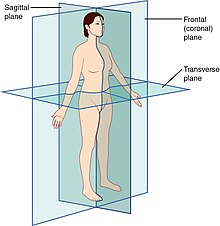
Trạng thái chức năng[sửa | sửa mã nguồn]
Anatomical terms may be used to describe the functional state of an organ: [cần dẫn nguồn]
Những thuật ngữ mô tả trạng thái chức năng bao gồm:
- tiếp nối (anastomoses) là những "ngã ba" nơi những cấu trúc như mạch máu và mạch lá (thực vật) nối với nhau'
- patent
- đám rối (plexus) là cấu trúc dạng mạng lưới của dây thần kinh
Biến dị giải phẫu[sửa | sửa mã nguồn]
The term anatomical variation is used to refer to a difference in anatomical structures that is not regarded as a disorder. Many structures vary slightly between people, for example muscles that attach in slightly different places. For example, the presence or absence of the palmaris longus tendon. Anatomical variation is unlike congenital anomalies, which are considered a disorder.[12]
Cử động[sửa | sửa mã nguồn]
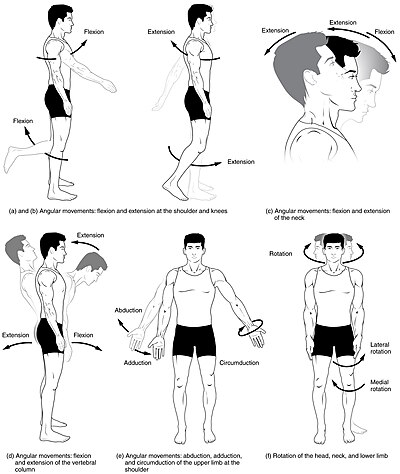
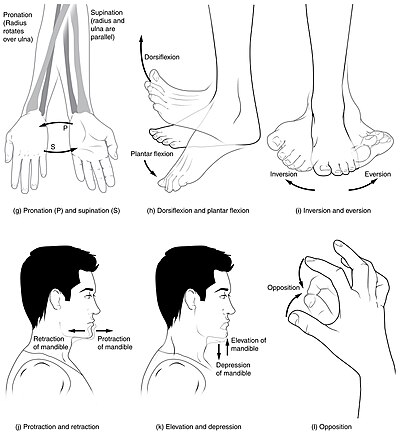
Các khớp, đặc biệt là khớp hoạt dịch, cho phép cơ thể thực hiện một loạt các cử động. Mỗi cử động mở một khớp hoạt dịch là kết quả của sự căng hoặc duỗi cơ gắn với mỗi bên của xương liên quan đến cử động. Phân loại của cử động phụ thuộc vào cấu trúc của khớp hoạt dịch.
Các loại cử động thường đi thành cặp, và chúng luôn được mô tả trong tương quan với những hướng của tư thế giải phẫu chuẩn.[11]
Cử động chung[sửa | sửa mã nguồn]
Cử động chung của cơ thể bao gồm
- gập (flexion) và duỗi (extension): những cử động làm giảm góc (gập) hay tăng góc (duỗi) giữa hai bên khớp.
- dạng (abduction) và khép (adduction): những cử động ra khỏi đường giữa (dạng) hay về đường giữa (khép)
- xoay vào trong (hay xoay vào giữa) và xoay ra ngoài (hay xoay ra bên): những cử động xoay ra khỏi hoặc vào trong trung tâm cơ thể. Ví dụ, khi đứng hai bàn chân chụm từ tư thế hai bàn chân chữ V, chân xoay vào trong.
- nâng (elevation) và hạ (depression): thường dùng cho cử động vùng vai và hàm.[13]
Cử động đặc biệt của tay và chân[sửa | sửa mã nguồn]
Tay và chân có các cử động đặc biệt, bao gồm:[14]:590–7
- gấp mu bàn chân (dorsiflexion) và gấp lòng bàn chân (plantarflexion): là các cử động của cổ chân, gấp lòng bàn chân là khi ta kiễng chân (nhón chân).
- gấp mu bàn tay (dorsiflexion) và gấp lòng bàn tay (palmarflexion): là các cử động của cổ tay, gấp mu bàn tay là khi ta chắp tay bái lạy.
- quay sấp (pronation) và quay ngửa (supination): là cử động xoay của cẳng tay, sao cho lòng bàn tay hướng lên trên (quay ngửa) hoặc hướng xuống dưới (quay sấp). Khi ta bưng chén nước thì tay ta đang quay ngửa, ngón cái chỉa ra ngoài, lòng bàn tay hướng lên. Khi ta đánh máy thì tay ta đang quay sấp, ngón cái chỉa vào giữa, lòng bàn tay hướng xuống.
- lộn ra (eversion) và lộn vào (inversion): là cử động xoay sao cho hai lòng bàn chân hướng vào giữa (lộn vào) hoặc ra ngoài (lộn ra).
Cơ[sửa | sửa mã nguồn]
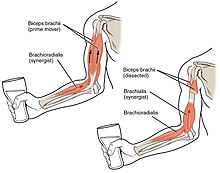
Cử động cơ được thực hiện ở một khớp với một nguyên ủy và một bám tận ở hai bên khớp. Bám tận của xương thường đước kéo gần về nguyên ủy khi co cơ. Các cơ
Muscle action that moves the axial skeleton work over a joint with an origin and insertion of the muscle on respective side. The insertion is on the bone deemed to move towards the origin during muscle contraction. Muscles are often present that engage in several actions of the joint; able to perform for example both flexion and extension of the forearm as in the biceps and triceps respectively.[11] This is not only to be able to revert actions of muscles, but also brings on stability of the actions though muscle coactivation.[15]
Cơ chủ vận, cơ đối vận, cơ đồng vận[sửa | sửa mã nguồn]
Với mỗi cử động, cơ co để thực hiện là cơ chủ vận, còn cơ khi co sẽ phủ định cử động đó là cơ đối vận. Ví dụ, sự duỗi cẳng tay có cơ ba đầu là cơ chủ vận, cơ hai đầu là cơ đối vận vì cơ hai đầu cơ có khả năng thực hiện sự gập cẳng tay - chuyển động phủ định của duỗi cẳng tay. Những cơ phối hợp để thực hiện cùng một cử động là cơ đồng vận. Như ở trong ví dụ trên, cơ cánh tay có thể là cơ đồng vận với cơ ba đầu.[11]
Cơ xương và cơ trơn[sửa | sửa mã nguồn]
Giải phẫu đại thể về cơ là chỉ thị quan trọng nhất của vai trò của cơ đó đối với cơ thể. Một trong những khía cạnh quan trọng của giải phẫu đại thể về cơ là tính pennate (tạm dịch: hình lông vũ). Ở hầu hết cơ, tất cả sợi cơ có cùng hướng, chạy song song từ nguyên ủy đến bám tận. Trong cơ pennate, sợi cơ xếp hơi chéo với trục chính của cơ. Khi co, cơ pennate thay đổi ít hơn về độ dài, nhưng lực gây ra mạnh hơn. Đó là vì sự co của mỗi sợi cơ diễn ra ở một góc với trục co chính của bó cơ, nhưng cách xếp này cho phép nhiều sợi cơ chen vào hơn. Cơ pennate thường xuất hiện ở những vùng mà biến thiên độ dài ít quan trọng hơn lực mạnh, ví dụ như ở cơ thẳng của đùi.[16]
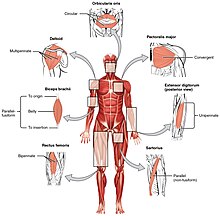
Cơ xương thường là các cơ riêng rẽ, ví dụ như cơ hai đầu.
Skeletal muscle is arranged in discrete muscles, an example of which is the biceps brachii. The tough, fibrous epimysium of skeletal muscle is both connected to and continuous with the tendons. In turn, the tendons connect to the periosteum layer surrounding the bones, permitting the transfer of force from the muscles to the skeleton. Together, these fibrous layers, along with tendons and ligaments, constitute the deep fascia of the body.[16]
Khớp[sửa | sửa mã nguồn]
Phân loại theo cấu trúc, có ba loại khớp:[17]
- Khớp sợi (fibrous joints) hoặc khớp bất động (immovable joints): ví dụ như khớp ở sọ
- Khớp gân (cartilaginous joints) hoặc khớp bán động (partly movable joints): ví dụ như khớp liên xương chậu, khớp xương sống. Khớp gân có thể được phân loại thành khớp sụn (synchondrosis) và khớp màng (symphysis)
- Khớp hoạt dịch (synovial joints) hoặc khớp động (movable joints): là khớp cho phép cử động rộng và linh hoạt nhất.
Phân loại các khớp hoạt dịch theo chức năng, có 6 loại khớp:[18] [17]
- Khớp trượt (gliding joint) hoặc khớp phẳng (planar joint)
- Khớp bản lề (hinge joint)
- Khớp xoay (pivotal joint)
- Khớp lồi cầu (condyloid joint) hoặc khớp dạng elip (ellipsoid joint)
- Khớp yên ngựa (saddle joint)
- Khớp ổ - cầu (ball and socket joint)
Khoang cơ thể[sửa | sửa mã nguồn]
The body maintains its internal organization by means of membranes, sheaths, and other structures that separate compartments, called body cavities. The ventral cavity includes the thoracic and abdominopelvic cavities and their subdivisions. The dorsal cavity includes the cranial and spinal cavities.[11]
Màng[sửa | sửa mã nguồn]
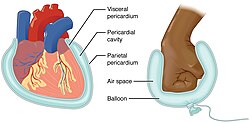
A serous membrane (also referred to as a serosa) is a thin membrane that covers the walls of organs in the thoracic and abdominal cavities. The serous membranes have two layers; parietal and visceral, surrounding a fluid filled space.[1] The visceral layer of the membrane covers the organ (the viscera), and the parietal layer lines the walls of the body cavity (pariet- refers to a cavity wall). Between the parietal and visceral layers is a very thin, fluid-filled serous space, or cavity.[1] For example, the pericardium is the serous cavity which surrounds the heart.[1]
Additional images[sửa | sửa mã nguồn]
-
Older set of terminology shown in Parts of the Human Body: Posterior and Anterior View from the 1933 edition of Sir Henry Morris' Human Anatomy. See also List of human anatomical regions § Deprecated or older regions.
-
Labels of human body features displayed on images of actual human bodies, from which body hair and male facial hair have been removed.
See also[sửa | sửa mã nguồn]
References[sửa | sửa mã nguồn]
- ^ a b c d e f g h i j k l m n o
 Bài viết này tích hợp văn bản đã phát hành theo giấy phép CC BY 4.0. Betts, J Gordon; Desaix, Peter; Johnson, Eddie; Johnson, Jody E; Korol, Oksana; Kruse, Dean; Poe, Brandon; Wise, James; Womble, Mark D; Young, Kelly A (26 tháng 2 năm 2016). Anatomy & Physiology. Houston: OpenStax CNX. 1.6. Anatomical Terminology. ISBN 978-1-93-816813-0. ID: 14fb4ad7-39a1-4eee-ab6e-3ef2482e3e22@8.24.
Bài viết này tích hợp văn bản đã phát hành theo giấy phép CC BY 4.0. Betts, J Gordon; Desaix, Peter; Johnson, Eddie; Johnson, Jody E; Korol, Oksana; Kruse, Dean; Poe, Brandon; Wise, James; Womble, Mark D; Young, Kelly A (26 tháng 2 năm 2016). Anatomy & Physiology. Houston: OpenStax CNX. 1.6. Anatomical Terminology. ISBN 978-1-93-816813-0. ID: 14fb4ad7-39a1-4eee-ab6e-3ef2482e3e22@8.24.
- ^ a b c Drake, Richard L.; Vogl, Wayne; Tibbitts, Adam W.M. Mitchell (2005). Gray's anatomy for students. illustrations by Richard Richardson, Paul . Philadelphia: Elsevier/Churchill Livingstone. ISBN 978-0-443-06612-2.
- ^ Federative Committee on Anatomical Terminology (2008). Terminologia Histologica – International Terms for Human Cytology and Histology. Cardiff: Lippincott Williams & Wilkins. ISBN 978-0-7817-6610-4. OCLC 63680504.
- ^ Federative Committee on Anatomical Terminology (1998). Terminologia Anatomica – International Anatomical Terminology. Stuttgart: Thieme. ISBN 978-3-13-115251-0. OCLC 43947698.
- ^ Losardo, Ricardo J. (2009). “Pan American Association of Anatomy: history and relevant regulations”. Int J Morphol. 27 (4): 1345–52. ISSN 0717-9367.
- ^ "Terminologia Anatomica" tại Từ điển Y học Dorland [liên kết hỏng]
- ^ Terminologia Anatomica: International Anatomical Terminology. New York: Thieme Medical Publishers. 1998. ISBN 978-0-86577-808-5.
- ^ Engelbrecht, Rolf (2005). Connecting Medical Informatics And ... - Google Book Search. IOS Press. ISBN 9781586035495. Truy cập ngày 22 tháng 8 năm 2008.
- ^ Ten Donkelaar, Hans J.; Broman, Jonas; Neumann, Paul E.; Puelles, Luis; Riva, Alessandro; Tubbs, R. Shane; Kachlik, David (1 tháng 3 năm 2017). “Towards a Terminologia Neuroanatomica”. Clinical Anatomy. 30 (2): 145–155. doi:10.1002/ca.22809. ISSN 1098-2353. PMID 27910135. S2CID 32863255.
- ^ Strzelec, B.; Chmielewski, P. P.; Gworys, B. (2017). “The Terminologia Anatomica matters: examples from didactic, scientific, and clinical practice”. Folia Morphologica. 76 (3): 340–347. doi:10.5603/FM.a2016.0078. ISSN 1644-3284. PMID 28026851.
- ^ a b c d e f Betts, J Gordon; Desaix, Peter; Johnson, Eddie; Johnson, Jody E; Korol, Oksana; Kruse, Dean; Poe, Brandon; Wise, James; Womble, Mark D; Young, Kelly A (3 tháng 10 năm 2013). Anatomy & Physiology. Houston: OpenStax CNX. 1.6. Anatomical Terminology. ISBN 978-1-93-816813-0. ID: 14fb4ad7-39a1-4eee-ab6e-3ef2482e3e22@6.11. Truy cập ngày 16 tháng 11 năm 2013.
- ^ DeSilva, Malini; Munoz, Flor M.; Mcmillan, Mark; Kawai, Alison Tse; Marshall, Helen; Macartney, Kristine K.; Joshi, Jyoti; Oneko, Martina; Rose, Annette Elliott (1 tháng 12 năm 2016). “Congenital anomalies: Case definition and guidelines for data collection, analysis, and presentation of immunization safety data”. Vaccine. 34 (49): 6015–6026. doi:10.1016/j.vaccine.2016.03.047. ISSN 0264-410X. PMC 5139892. PMID 27435386.
- ^ “Types of movements in the human body”. Kenhub. Truy cập ngày 3 tháng 9 năm 2019.
- ^ Swartz, Mark H. (2010). Textbook of physical diagnosis : history and examination (ấn bản 6). Philadelphia, PA: Saunders/Elsevier. ISBN 978-1-4160-6203-5.
- ^ Castrogiovanni, Paola; Conway, Nerys; Imbesi, Rosa; Trovato, Francesca Maria (tháng 9 năm 2016). “Morphological and Functional Aspects of Human Skeletal Muscle”. Journal of Functional Morphology and Kinesiology. 1 (3): 289–302. doi:10.3390/jfmk1030289.
- ^ a b Moore, Keith L.; Dalley, Arthur F.; Agur, Anne M. R. (2010). Moore's Clinically Oriented Anatomy. Phildadelphia: Lippincott Williams & Wilkins. tr. 29–35. ISBN 978-1-60547-652-0.
- ^ a b “Types Of Joints - Classification of Joints in the Human Body”. BYJUS (bằng tiếng Anh). Truy cập ngày 18 tháng 5 năm 2024.
- ^ “9.1 Classification of Joints – Anatomy and Physiology”. opentextbc.ca. Bản gốc lưu trữ ngày 29 tháng 3 năm 2019. Truy cập ngày 3 tháng 9 năm 2019.
Further reading[sửa | sửa mã nguồn]
- Calais-Germain, Blandine (1993). Anatomy of Movement. Eastland Press. ISBN 978-0-939616-17-6.
- Drake, Richard; Vogl, Wayne; Mitchell, Adam (2004). Gray's Anatomy for Students. Churchill Livingstone. ISBN 978-0-443-06612-2.
- Martini, Frederic; Timmons, Michael; McKinnley, Michael (2000). Human Anatomy (ấn bản 3). Prentice-Hall. ISBN 978-0-13-010011-5.
- Marieb, Elaine (2000). Essentials of Human Anatomy and Physiology (ấn bản 6). Addison Wesley Longman. ISBN 978-0-8053-4940-5.
- Muscolino, Joseph E. (2005). The Muscular System Manual: The Skeletal Muscles of the Human Body (ấn bản 2). C.V. Mosby. ISBN 978-0-323-02523-2.
- Ngai, Steven (2006). Understanding Anatomical Latin (PDF) (ấn bản 3). Bản gốc (PDF) lưu trữ ngày 25 tháng 3 năm 2009. Truy cập ngày 15 tháng 11 năm 2015.
- Losardo, R. J.; Valverde Barbato De Prates, N. E.; Arteaga-Martinez, M.; García Peláez, M. I.; Cabral, R. H. (2017). “International Morphological Terminology (anatomy, histology and embryology): beyond scientific terms”. Journal of Morphological Sciences. 34 (3): 130–133. doi:10.4322/jms.109916. ISSN 2177-0298.
Sources[sửa | sửa mã nguồn]
Bản mẫu:Free-content attribution
Bản mẫu:Human systems and organs Bản mẫu:Human regional anatomy

